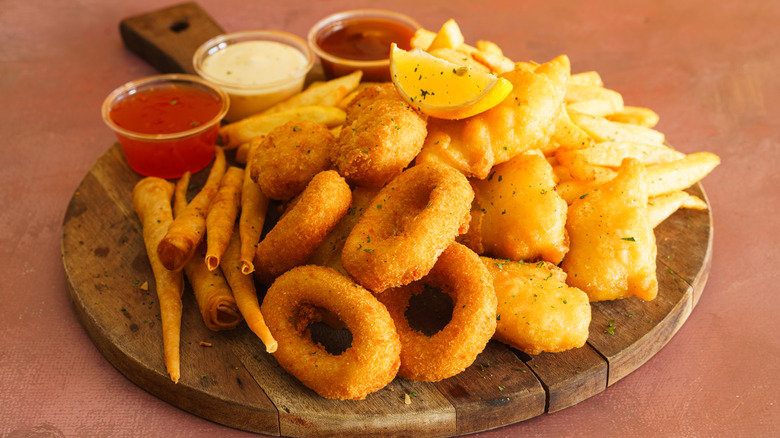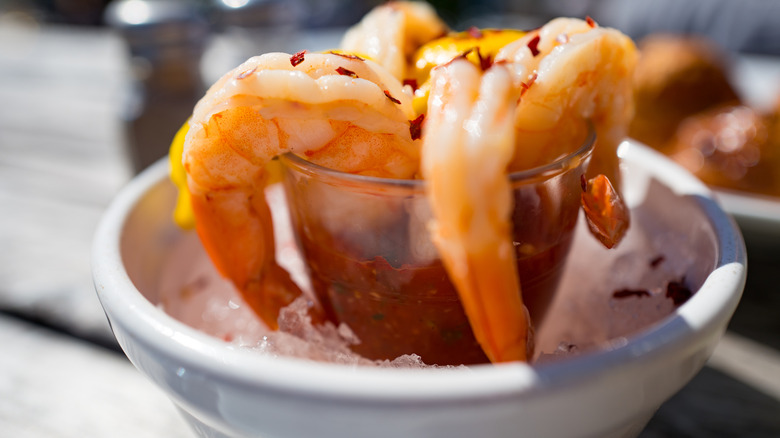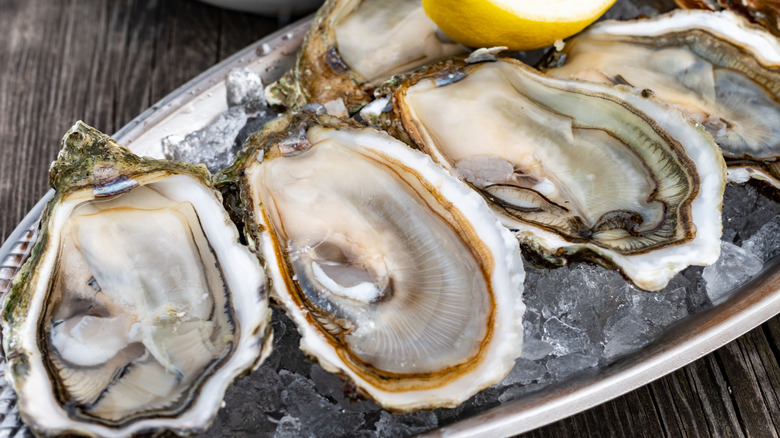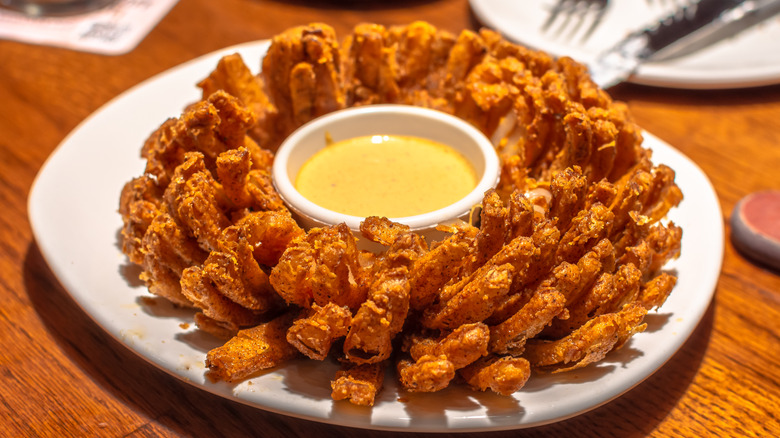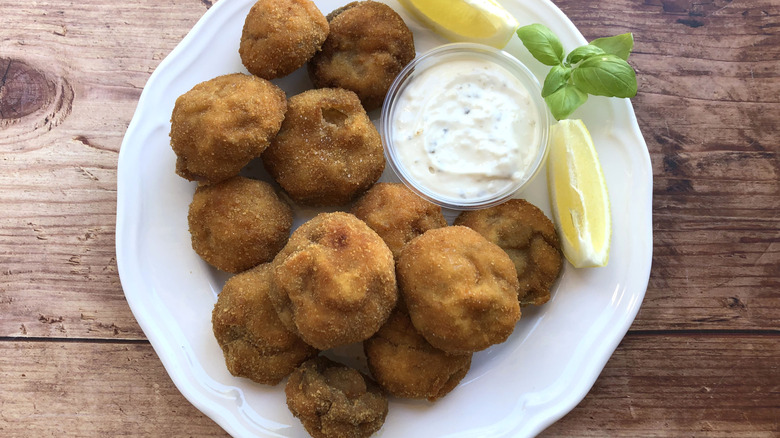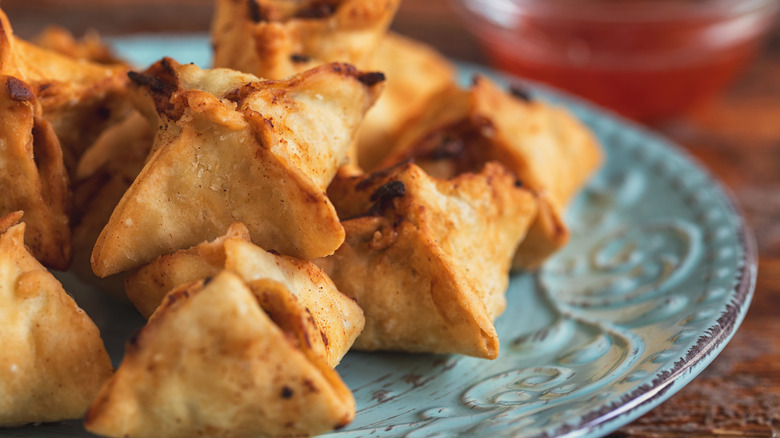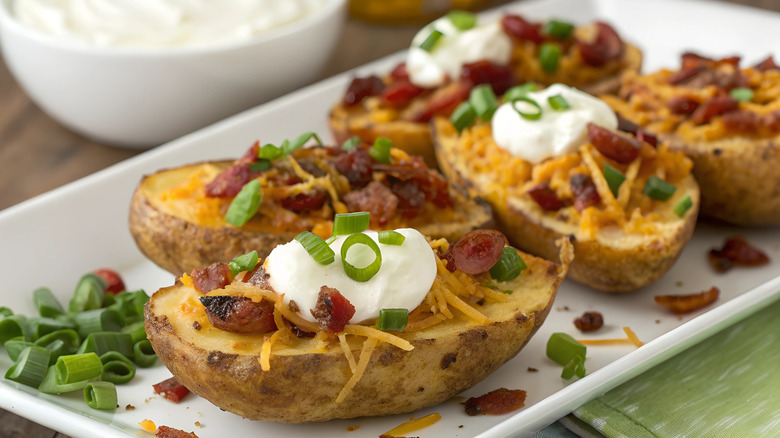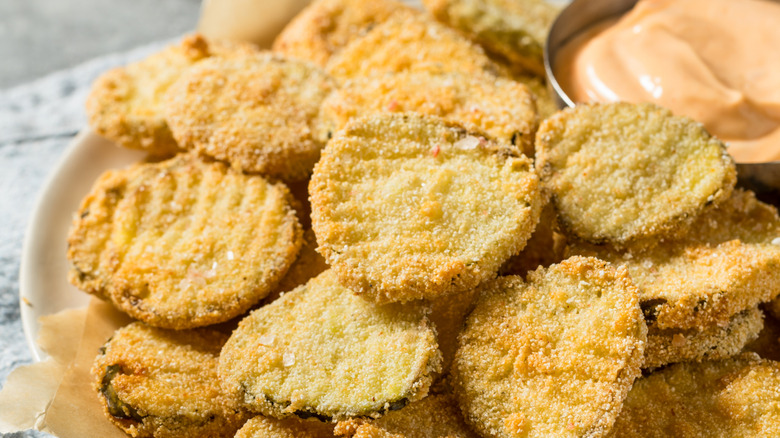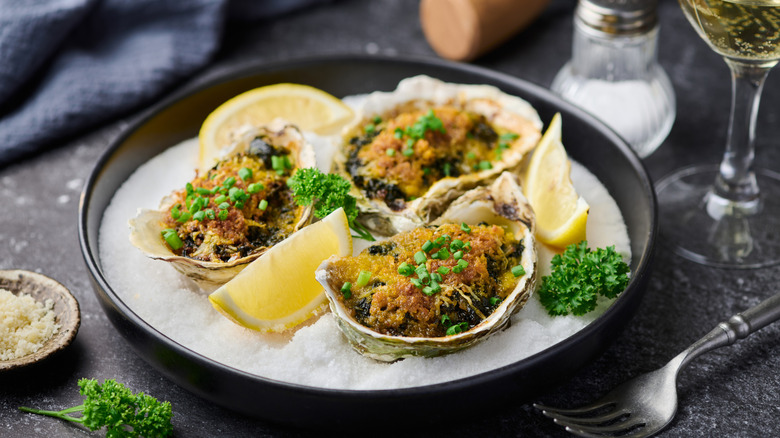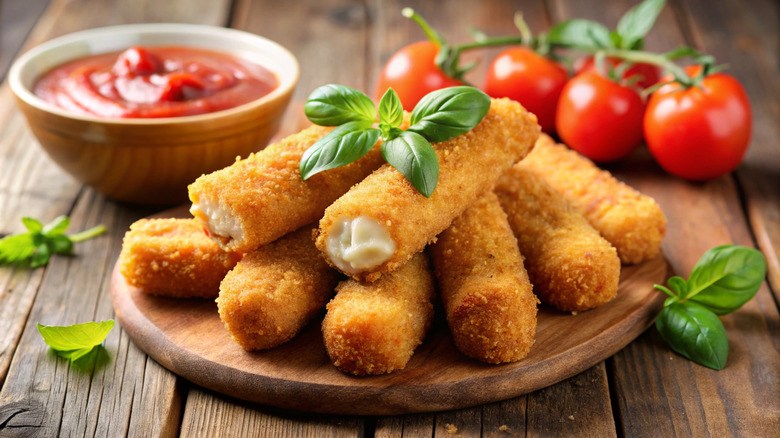Outdated Chain Restaurant Appetizers That Seriously Need To Go
We all love an appetizer, but choosing one is more of an art form than you might think. The perfect appetizer should complement a dish without overshadowing it, and should whet an appetite while avoiding filling you up. In restaurants, appetizers also serve as the first introduction to the meal itself, and their visual appearance is everything: A well-presented app will give you confidence that the kitchen's got your back.
Unfortunately, however, chain restaurants sometimes forget all of these things are important. Instead, many of the biggest chain restaurants out there churn out appetizers that feel totally past their prime, often opting for the "classics" that just don't gel properly with modern tastes, nor with the entrees on their menu. A lot of the time, these appetizers feel too heavy or greasy for the meal itself, and end up ruining your appetite before the dining experience has really begun. Elsewhere, they feel like they're plucked straight from the history books, where they should be banished to once more. Some of these appetizers might be your favorites, but we're here to explain to you exactly why it's time for restaurants to hang them up and try something a little braver.
Shrimp cocktail
Okay, let's just get this one out of the way. We like shrimp cocktails as much as the next person. Despite it being considered as somewhat of a culinary joke, there's something about the combination of shrimp and that tangy cocktail sauce that does hit the spot every now and again. However, there's no denying that it's an outdated affair. Shrimp cocktail first gained popularity in the late 1950s, with Las Vegas commonly being recognized as its birthplace. By the mid-1960s it was available at virtually every hotel in the city, and it soon spread beyond the confines of the desert to dominate buffet counters and wedding brunches nationwide.
However, by the 1980s it was already starting to feel old-school, and nowadays it just feels like a relic. Plus, there's no denying that the sauce used in shrimp cocktail can just be way too dominant for an appetizer and overwhelm the delicate flavor of the shrimp. This is a brash first course that feels a little silly these days, and although seafood chain restaurants like Red Lobster still serve them by the fistful, there are so many more interesting options out there.
Raw oysters
Raw oysters are still seen by many people as the height of elegance, and chain steakhouses (as well as plenty of smaller and independently-owned steakhouses) still serve them regularly. Our question is, why? Well, we know why: because they're fancy, and people like to treat themselves. However, when you consider how much we know about the risks involved, it seems wild that we're still persisting with eating this seafood uncooked. Raw oysters are uniquely prone to causing several illnesses, including Vibrio and norovirus infection, as well as hepatitis A. These illnesses can all cause incredibly nasty symptoms, with immediate medical attention often required.
Infection from Vibrio bacteria is especially dangerous, with approximately 100 people dying from vibriosis each year in the United States. The problem with oysters is that they're particularly susceptible to carrying Vibrio bacteria due to their feeding methods, which involve filtering water through their system. With all this in mind, why on earth would you risk eating them raw? Instead, we'd thoroughly recommend only eating oysters that are well-cooked, no matter how much a restaurant promises that its food is safe to eat. Chain restaurants, too, should really know by now that they're playing with fire with this appetizer.
Blooming onion
Oh, the blooming onion. There's no denying that it's a showstopper, guys. This over-the-top appetizer is made by cutting an onion into dozens (if not hundreds) of individual petals, before breading and deep-frying the whole thing. The classic Bloomin' Onion was created by Outback Steakhouse in 1988, but you can find a host of imitators in other chain restaurants, too. It's basically like a supersized version of an onion ring, and it's pretty tasty.
However, here's the deal: It's 2025. Surely we're beyond serving massive hunks of deep-fried onion at the start of a meal? The blooming onion may be tasty enough the first time you bite into one of its petals, but by the fifth mouthful you'll be completely full up. If we're being totally honest, the blooming onion is a relic of 90s food culture, which was all about novelty and not really about taste. It's gaudy, it's ungainly, and you probably won't get through the whole thing, leading to you contributing to food waste. Grab yourself an order of onion rings to share, and save yourself the money.
Battered mushrooms
Battered mushrooms feel, to us, like a waste of money. We're not sure exactly when chain restaurants insisted on putting them on their menus, but nowadays you can find them everywhere, especially in restaurants like TGI Fridays. The problem with them is that they just never quite hit the spot. Battered mushrooms are often flavorless and have an unpleasant squidgy-ness to them, and the mushrooms quickly fall out of the batter instead of staying incorporated with it. They can also be just a bit too greasy, giving your mouth an unpleasant film which gets in the way of your entree's flavor.
Having said this, there are certainly occasions where battered mushrooms hit the spot. If you manage to find a restaurant that sells delicately crumbed enoki mushrooms, which can serve as a light appetizer that's especially good at emulating meat textures and flavors, they can be a great choice. This is especially true if there's some real flavor innovation going on, instead of just plonking them down next to a sugary marinara sauce, which so many restaurants resort to doing. If your restaurant of choice isn't doing anything special with them, though, and it's just serving white mushrooms covered in thick batter, avoid them entirely.
Crab rangoon
Crab rangoon is a mysterious dish, both in terms of its taste and in terms of its origins. This food fusion icon was apparently invented by Trader Vic's, although others point towards it being created in Myanmar (alternatively and formerly known as Burma). No matter where it came from originally, though, crab rangoon quickly infiltrated Chinese-American cuisine and became one of the most popular appetizers out there. It's now a staple of Chinese-American restaurants and chains, both in the United States and worldwide.
However, we think it's time to leave this starter on the shelf. Crab rangoon is distinguished by each wonton wrapper being stuffed with cream cheese and deep-fried, which may be tasty but which certainly isn't authentic. That may not matter to a lot of people (and on a taste level, maybe it doesn't), but when you consider the massive diversity of flavors and textures available in Chinese cuisine, why wouldn't you take the opportunity to get something a little more traditional and unique? Plus, the creaminess of crab rangoon just doesn't quite work with the rest of the flavor and texture profile of a typical Chinese meal. There's nothing wrong with enjoying them as a snack in isolation, but we just don't think they work as an appetizer.
Spinach dip
We long for a world where chain restaurants serve appetizers that don't feel like they're going to ruin your appetite. For some people, seeing spinach dip on the menu can seem like their restaurant is doing just that: After all, how filling can blended spinach loaded onto a cracker be? Unfortunately, though, most spinach dips are not that simple. Instead, chain restaurant spinach dips (and spinach and artichoke dips) are heavy, clunky affairs which mix the vegetable with cheese, and a lot of it. The result is an appetizer that can be more filling than anything else on the menu.
This combo might have been appealing once upon a time, but in today's food world it just feels like too much. Food trends these days tend to emphasize bright, fresh, vegetal flavors that aren't drowned out by other, richer ingredients. We'd much prefer an appetizer of crisp veggies or roasted root vegetables which are caramelized to bring out their natural sugars, instead of what is essentially a green-colored cheese dip.
Loaded potato skins
By all accounts, loaded potato skins should be gone by now. The invention of this appetizer is disputed, but it started to appear around the early to mid-1970s, with restaurants like TGI Fridays placing them on their menu. Pretty soon, the popularity of potato skins exploded. By the '80s they were everywhere, with people falling in love rapidly with the combination of a handheld potato piece and all of the toppings you could dare to dream of.
Look, we understand the appeal. Potato skins are delicious, they're filling, and they're often cost-effective. However, their heyday was all and truly in the 1980s, and nowadays they feel like the chef has simply forgotten to take them off the menu. Nonetheless, chain restaurants like Bennigans still champion them proudly at their branches, in turn making the eateries themselves feel a bit like they're stuck in the past. If you want potato skins, go ahead and order them, but just be aware that you'll likely be full by the time your entree arrives.
Battered shrimp
This might be a bit of a controversial one, but just go with us here. Battered shrimp is an all-time favorite appetizer and it appears on menus for seafood and non-seafood chain restaurants alike. If you're in the market for battered protein to start off your meal, it's hard to go wrong: The flavor is universally appealing, each piece is handheld, and it's a great sharing option.
However, isn't it just a little bit unoriginal? Why, we ask, would you go all the way to a restaurant, and then pick something like battered shrimp instead of a more interesting option? Plus, there's no getting around the fact that battering and deep-frying shrimp completely saps the seafood of its delicate flavor. You could put basically anything inside that batter and it'd still taste of fat and salt, and barely any of the shrimp's sweetness shines through. We'd much prefer to have a plate of sautéed shrimp that tastes simultaneously light and punchy, like gambas al ajillo. You'll still feel hungry for your main course, but your appetite will have been slightly sated.
Fried pickles
Like many appetizers that have somewhat outstayed their welcome, fried pickles were invented in the 1960s. The concept of taking a pickle, coating it in batter, and deep-frying it was championed by Bernell "Fatman" Austin, an Arkansas-based businessman and the owner of the Duchess Drive-In. Pretty soon, a food sensation was created, and the fried pickle passed from being an oddity that you'd find at county fairs and smaller fast food joints to being proudly served as an appetizer in some of the biggest chain restaurants around. Nowadays, Texas Roadhouse sells countless orders of fried pickles daily.
Now, we get the draw of fried pickles: The combination of the salty, briny smack of the dill pickle and the tender crunch of the batter is quite something. However, let's be honest, folks. This appetizer needs to go. In a world where there's so much choice on offer and so much diversity in the food world, the concept of opting for a batter-covered piece of cucumber is just a bit wild. We're not judging anyone for their taste, but aren't we at a point now where we can dream a little bigger?
Oysters Rockefeller
When you see Oysters Rockefeller on a chain restaurant menu, it can feel like you've stepped back into another time. This appetizer was invented way back in the late 19th century, with restauranteur Jules Alciatore figuring out an alternative to serving snails in his father's eatery. He conceived of serving half-shell oysters with a green sauce on top, with the color of the sauce leading to the name: The green was reminiscent of money, so Alciatore named the dish after the famous millionaire J. D. Rockefeller.
The popularity of Oysters Rockefeller quickly spread around the country, and before long it was seen in steakhouses and seafood restaurants across the land. However, nowadays, it feels like a dish from a bygone era. There's nothing necessarily wrong with this appetizer, and for some folks it can feel like a trip down memory lane, or that they're engaging in a little piece of American history. However, there's no denying that its glory days are over. You're pretty unlikely to find Oysters Rockefeller in larger chains these days, but it still shows up in smaller ones and chainlets, such as the East Coast steakhouse chain The Prime Ribs, across America.
Mozzarella sticks
Before you all yell at us, stop! We can explain. Now, we know that mozzarella sticks are one of the most popular appetizers out there, but they kind of go against the point of an appetizer itself. The very concept of an appetizer is that it stimulates your appetite, not gets rid of it entirely. Mozzarella sticks, in all of their dense, cheesy, deep-fried glory, are often incredibly heavy and filling, and end up making you enjoy your meal less. They may be fine to order in a fast food joint, but when you're having a sit-down meal in a chain restaurant, they're just too much.
We instead consider mozzarella sticks to be a hangover from that era where heavier, often deep-fried appetizers were all the rage. Along with potato skins and fried pickles, mozzarella sticks were big in the 1970s and 1980s, thanks in part to string cheese taking off in full and some clever folks realizing that it could be deep-fried. When you pair that with the surge in restaurant chains like Applebee's and TGI Fridays around the time, the desire folks had to try new (yet familiar) foods, and the relative cheapness of mozzarella itself, it's no wonder that they started appearing everywhere. However, it's a different world now, and mozzarella sticks just feel past their prime.
